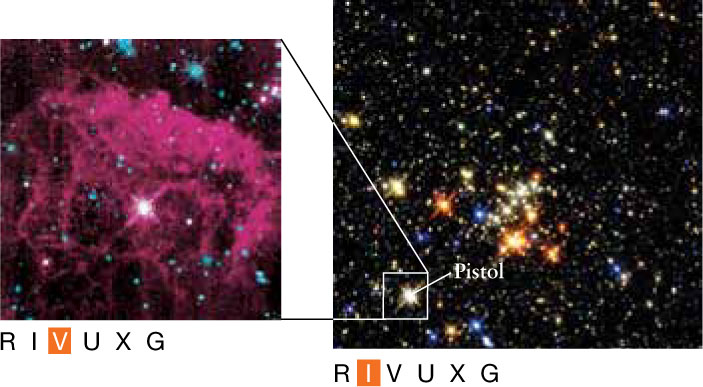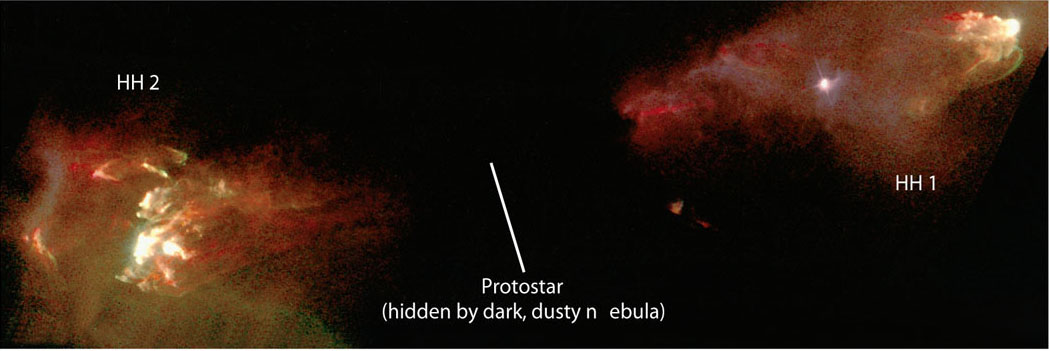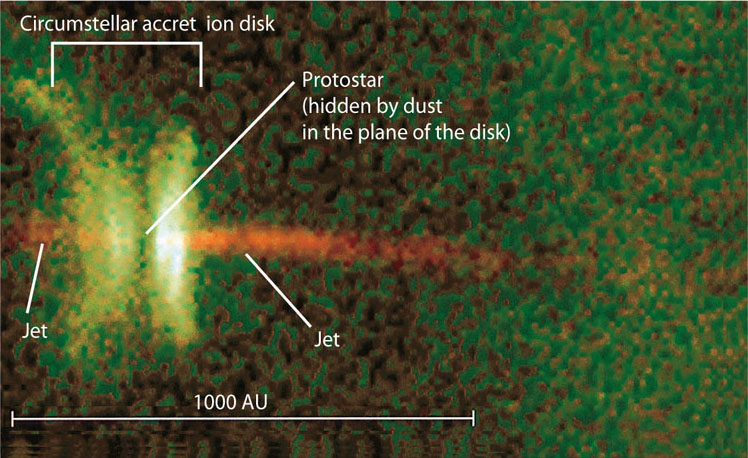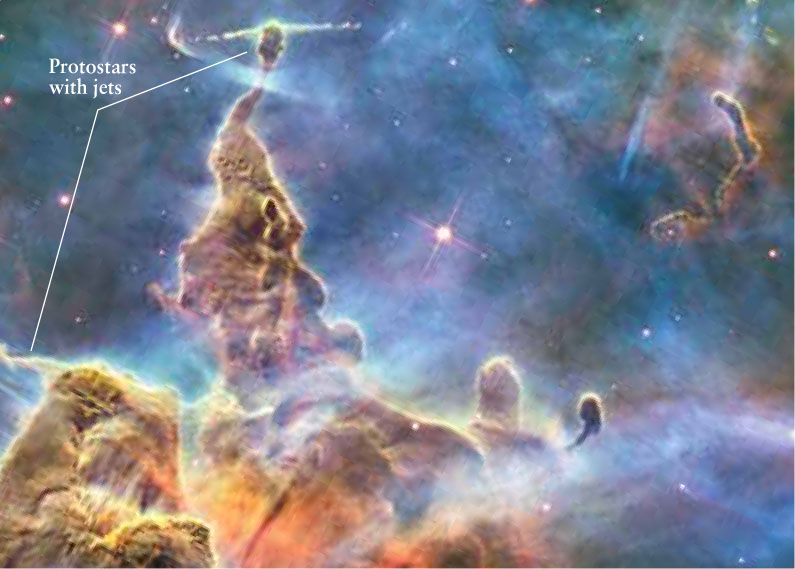18-5 During the birth process, stars both gain and lose mass
Before settling down, protostars eject more than half of their initial mass into space
After reading the previous section, you may think that a main-sequence star forms simply by collapsing inward. In fact, much of the material of a cold, dark nebula is ejected into space and never incorporated into stars. As it is ejected, this material may help sweep away the dust surrounding a young star, making the star observable at visible wavelengths.
T Tauri Stars

Mass ejection into space is a hallmark of T Tauri star. These objects are protostars with emission lines as well as absorption lines in their spectra and whose luminosity can change irregularly on timescales of a few days. The namesake of this class of stars, T Tauri, is a protostar in the constellation Taurus (the Bull).
T Tauri stars have final masses less than about 3 M⊙ and ages around 106 years, so on an H-R diagram such as Figure 18-10 they appear above the right-hand end of the main sequence. (The stellar masses shown in Figure 18-10 are those of the final, main-sequence stars.) The emission lines show that these protostars are surrounded by a thin, hot gas. The Doppler shifts of these emission lines suggest that the protostars eject gas at speeds around 80 km/s (300,000 km/h, or 180,000 mi/h).
On average, T Tauri stars eject about 10–8 to 10–7 solar masses of material per year. This amount may seem small, but by comparison the present-day Sun loses only about 10–14 M⊙ per year. The T Tauri phase of a protostar may last 107 years or so, during which time the protostar may eject roughly a solar mass of material. Thus, the mass of the final main-sequence star is quite a bit less than that of the cloud of gas and dust from which the star originated.
Young protostars that are more massive than about 3 M⊙ do not vary in luminosity like T Tauri stars. They do lose mass, however, because the pressure of radiation at their surfaces is so strong that it blows gas into space (Figure 18-13).
Bipolar Outflows and Herbig-Haro Objects
 In the early 1980s, it was discovered that many young stars, including T Tauri stars, lose mass by ejecting gas along two narrow, oppositely directed jets—a phenomenon called bipolar outflow. As this material is ejected into space at speeds of several hundred kilometers per second, it collides with the surrounding interstellar medium and produces knots of hot, ionized gas that glow with an emission-line spectrum. These glowing knots are called Herbig-Haro objects after the two astronomers, George Herbig in the United States and Guillermo Haro in Mexico, who discovered them independently. Thus, a Herbig-Haro object is the observational manifestation of bipolar outflow around a star. Figure 18-14 is a Hubble Space Telescope image of the Herbig-Haro objects HH 1 and HH 2, which are produced by the two jets from a single young star in the constellation Orion. Herbig-Haro objects like these change noticeably in position, size, shape, and brightness from year to year, indicating the dynamic character of bipolar outflows.
In the early 1980s, it was discovered that many young stars, including T Tauri stars, lose mass by ejecting gas along two narrow, oppositely directed jets—a phenomenon called bipolar outflow. As this material is ejected into space at speeds of several hundred kilometers per second, it collides with the surrounding interstellar medium and produces knots of hot, ionized gas that glow with an emission-line spectrum. These glowing knots are called Herbig-Haro objects after the two astronomers, George Herbig in the United States and Guillermo Haro in Mexico, who discovered them independently. Thus, a Herbig-Haro object is the observational manifestation of bipolar outflow around a star. Figure 18-14 is a Hubble Space Telescope image of the Herbig-Haro objects HH 1 and HH 2, which are produced by the two jets from a single young star in the constellation Orion. Herbig-Haro objects like these change noticeably in position, size, shape, and brightness from year to year, indicating the dynamic character of bipolar outflows.

Bipolar Outflow and Herbig-Haro Objects The two bright knots of glowing, ionized gas called HH 1 and HH 2 are Herbig-Haro objects. They are created when fast-moving gas ejected from a protostar slams into the surrounding interstellar medium, heating the gas to high temperature. HH 1 and HH 2 are 0.34 pc (1.1 ly) apart and lie 470 pc (1500 ly) from Earth in the constellation Orion.
Observations suggest that most protostars eject material in the form of jets at some point during their evolution. These bipolar outflows are very short-lived by astronomical standards, a mere 104 to 105 years, but they are so energetic that they typically eject into space more mass than ends up in the final protostar.
In one object, water has been observed flowing out in the jets along with other material. The amount of water ejected each second is about 100 million times the amount of water flowing out of the Amazon River each second. The water in the jets moves at about 80 times the speed of a machine gun’s bullet and eventually slams into surrounding material about 5000 AU away.
Accretion Disks

A Circumstellar Accretion Disk and Jets This false-color image shows a T Tauri star surrounded by an accretion disk, which we see nearly edge-on. Red denotes emission from ionized gas, while green denotes starlight scattered from dust particles in the disk. The midplane of the accretion disk is so dusty and opaque that it appears dark. Two oppositely directed jets flow away from the star, perpendicular to the disk and along the disk’s rotation axis. This star, Herbig-Haro object HH 30, lies 140 pc (460 ly) from Earth.
Protostars slowly add mass to themselves at the same time that they rapidly eject it into space. In fact, the two processes are related. As a protostar’s nebula contracts, it spins faster and flattens into a disk with the protostar itself at the center. The same flattening took place in the solar nebula from which the Sun and planets formed (see Section 8-4). Particles orbiting the protostar within this disk collide with each other, causing them to lose energy, spiral inward onto the protostar, and add to the protostar’s mass. This process is called accretion, and the disk of material being added to the protostar in this way is called a circumstellar accretion disk. Figure 18-15 is an edge-on view of a circumstellar accretion disk, showing two oppositely directed jets emanating from a point at or near the center of the disk (where the protostar is located).
What causes some of the material in the disk to be blasted outward in a pair of jets? One model involves the magnetic field of the dark nebula in which the star forms (Figure 18-16). As material in the circumstellar accretion disk falls inward, it drags the magnetic field lines along with it. (We saw in Section 16-9 how a similar mechanism may explain the Sun’s 22-year cycle.) Parts of the disk at different distances from the central protostar orbit at different speeds, and this can twist the magnetic field lines into two helix shapes, one on each side of the disk. The helices then act as channels that guide initially infalling material away from the protostar, forming two opposing jets. While it’s clear that jets do form, the details of their formation are still uncertain. The star-forming region in Figure 18-17 shows two spectacular outflows from jets.


Star Formation and Jets While the protostars aren’t visible, some of their jets can be seen emanating from the thick gas and dust from which the stars are forming. As new stars form, their strong winds and intense ultraviolet radiation blow away lower-density material, leaving behind distinct regions with greater density. The denser material makes an ideal star-forming region to produce stars; the first few bright stars are already visible. This is only part of the 30 ly–wide Carina Nebula, which is about 7500 ly away.
Protoplanetary Disks
 In the 1990s, astronomers using the Hubble Space Telescope discovered many examples of disks around newly formed stars in the Orion Nebula (see Figure 18-1), one of the most prominent star-forming regions in the northern sky. Figure 8-8 shows a number of these protoplanetary disks, or proplyds, that surround young stars within the nebula. As the name suggests, protoplanetary disks are thought to contain the material from which planets form around stars. They are what remains of a circumstellar accretion disk after much of the material has either fallen onto the star or been ejected by bipolar outflows.
In the 1990s, astronomers using the Hubble Space Telescope discovered many examples of disks around newly formed stars in the Orion Nebula (see Figure 18-1), one of the most prominent star-forming regions in the northern sky. Figure 8-8 shows a number of these protoplanetary disks, or proplyds, that surround young stars within the nebula. As the name suggests, protoplanetary disks are thought to contain the material from which planets form around stars. They are what remains of a circumstellar accretion disk after much of the material has either fallen onto the star or been ejected by bipolar outflows.
Not all stars are thought to form protoplanetary disks; the exceptions probably include stars with masses in excess of about 3 M⊙, as well as many stars in binary systems. But surveys of the Orion Nebula show that disks are found around most young, low-mass stars. Thus, disk formation may be a natural stage in the birth of many stars.
CONCEPT CHECK 18-6
Protostars gain and lose mass on their way to the main sequence, but which effect is dominant in the formation of main-sequence stars with less than 3 M⊙?
For a main-sequence star that ends up with less than 3 M⊙ it was more massive as a protostar; these protostars lose more mass than they gain. The masses shown in Figure 18-10 are for the final main-sequence stars.